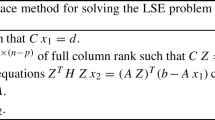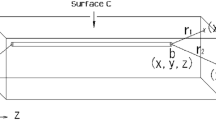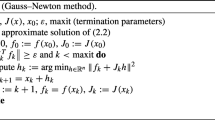Abstract
The standard approaches to solving overdetermined linear systems A x ≈ b construct minimal corrections to the vector b and/or the matrix A such that the corrected system is compatible. In ordinary least squares (LS) the correction is restricted to b, while in data least squares (DLS) it is restricted to A. In scaled total least squares (Scaled TLS) [15], corrections to both b and A are allowed, and their relative sizes depend on a parameter γ. Scaled TLS becomes total least squares (TLS) when γ = 1, and in the limit corresponds to LS when γ → 0, and DLS when γ → ∞.
In [13] we presented a particularly useful formulation of the Scaled TLS problem, as well as a new assumption that guarantees the existence and uniqueness of meaningful Scaled TLS solutions for all parameters γ > 0, making the whole Scaled TLS theory consistent. This paper refers to results in [13] and is mainly historical, but it also gives some simpler derivations and some new theory. Here it is shown how any linear system Ax ≈ b can be reduced to a minimally dimensioned core system satisfying our assumption. The basics of practical algorithms for both the Scaled TLS and DLS problems are indicated for either dense or large sparse systems.
Access this chapter
Tax calculation will be finalised at checkout
Purchases are for personal use only
Preview
Unable to display preview. Download preview PDF.
Similar content being viewed by others
References
Å. Björck, Numerical Methods for Least Squares Problems, SIAM Publications, Philadelphia PA, 1996.
G. Cirrincione, A Neural Approach to the Structure of Motion Problem, PhD thesis, LIS INPG Grenoble, 1998.
R. D. Fierro, G. H. Golub, P. C. Hansen and D. P. O’Leary, Regularization by truncated total least squares, SIAM J. Sci. Comput., 18: 1223–1241, 1997.
G. H. Golub, A. Hoffman and G. W. Stewart, A generalization of the EckartYoung-Mirsky matrix approximation theorem, Lin. Alg. Appl., 88/89:317327, 1987.
G. H. Golub and W. Kahan, Calculating the singular values and pseudo-inverse of a matrix, J. SIAM, Series B, Numer. Anal., 2: 205–224, 1965.
G. H. Golub and C. Reinsch, Singular value decomposition and least squares solutions, Numerische Mathematik, 14:403–420, 1970. Also in Handbook for Automatic Computation Vol. 2: Linear Algebra, by J. H. Wilkinson and C. Reinsch, (eds.), pp. 134–151, Springer, New York, 1971.
G. H. Golub and C. F. Van Loan, An analysis of the total least squares problem, SIAM J. Numer. Anal., 17: 883–893, 1980.
Matrix Computations, The Johns Hopkins University Press, Baltimore MD, third ed. 1996.
R. D. D. Groat and E. M. Dowling, The data least squares problem and channel equalization, IEEE Trans. Signal Processing, 42 (1): 407–411, 1993.
S. Van Huffel. Personal communication, June 1999.
S. Van Huffel and J. Vandewalle, The Total Least Squares Problem: Computational Aspects and Analysis, SIAM, Philadelphia, 1991.
C. C. Paige and M. A. Saunders, LSQR: An algorithm for sparse linear equations and sparse least squares, ACM Trans. Math. Software, 8: 43–71, 1982.
C. C. Paige and Z. Strakos, Scaled total least squares fundamentals, to appear in Numerische Mathematik.
C. C. Paige and Z. Strakos, Bounds for the least squares distance using scaled total least squares, to appear in Numerische Mathematik.
B. D. Rao, Unified treatment of LS, TLS and truncated SVD methods using a weighted TLS framework, In: S. Van Huffel (editor), Recent Advances in Total Least Squares Techniques and Errors-in-Variables Modelling, pp. 11-20, SIAM Publications, Philadelphia PA, 1997.
J. Wilkinson, The Algebraic Eigenvalue Problem, Clarendon Press, Oxford, 1965.
Author information
Authors and Affiliations
Editor information
Editors and Affiliations
Rights and permissions
Copyright information
© 2002 Springer Science+Business Media Dordrecht
About this chapter
Cite this chapter
Paige, C.C., Strakoš, Z. (2002). Unifying Least Squares, Total Least Squares and Data Least Squares. In: Van Huffel, S., Lemmerling, P. (eds) Total Least Squares and Errors-in-Variables Modeling. Springer, Dordrecht. https://doi.org/10.1007/978-94-017-3552-0_3
Download citation
DOI: https://doi.org/10.1007/978-94-017-3552-0_3
Publisher Name: Springer, Dordrecht
Print ISBN: 978-90-481-5957-4
Online ISBN: 978-94-017-3552-0
eBook Packages: Springer Book Archive




